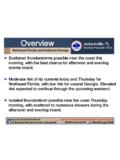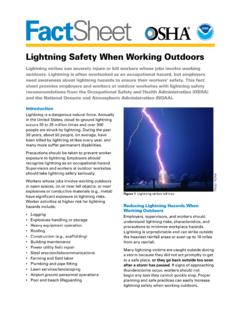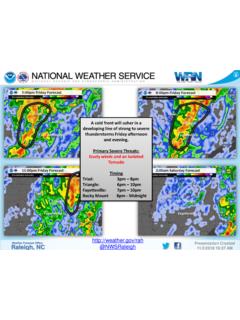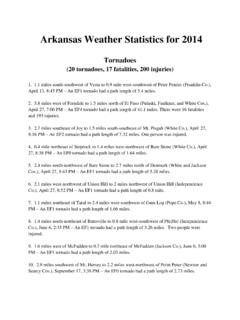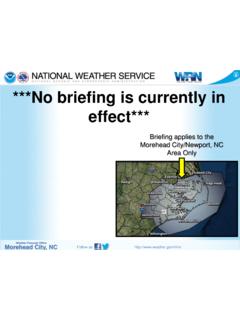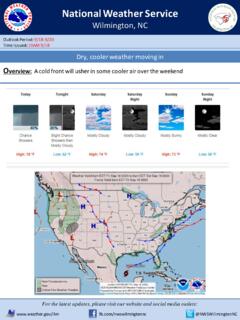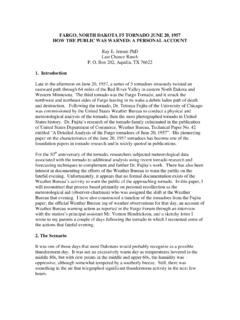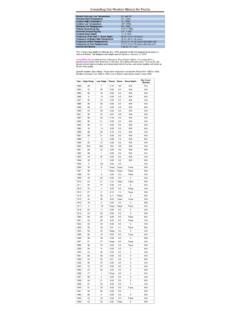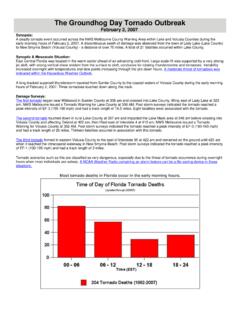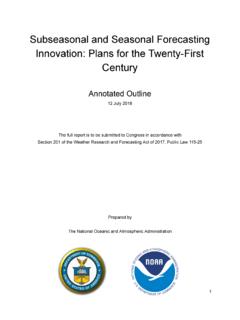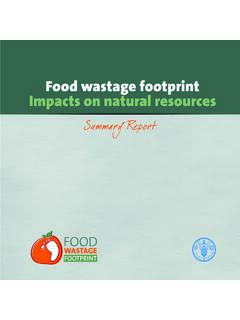Transcription of A History of Significant Weather Events in Southern California
1 A History of Significant Weather Events in Southern California Organized by Weather Type Updated May 2017 The following Weather Events occurred in or near the forecast area of the National Weather Service in San Diego, which includes Orange and San Diego Counties, southwestern San Bernardino County, and western Riverside County. Some Events from Los Angeles and surrounding areas are included. Events were included based on infrequency, severity, and impact. Note: This listing is not comprehensive. Table of Contents Heavy Rain: Flooding and Flash Flooding, Mud Slides, Debris Flows, Heavy Snow, Rare Snow at Low Severe Thunderstorms: Large Hail, Strong Thunderstorm Winds, and Killer (See flash flooding in heavy rain section) Tornadoes, Funnel Clouds, Waterspouts, and Damaging Dust Strong (For thunderstorm related winds, see severe thunderstorms) Extreme Extreme High Surf, Stormy Seas, Tsunamis, Coastal Flooding and Miscellaneous: Dense fog, barometric pressure, dry spells, Heavy Rain: Flooding and Flash Flooding, Mud Slides, Debris Flows, Landslides Date(s) Weather Adverse Impacts 1770, 1772, 1780, 1810, 1815, 1821, 1822, 1825, 1839, 1840, 1841,1842 Various reports from missions indicate Significant flooding along the Los Angeles, Santa Ana and San Diego Rivers, often changing the entire courses.
2 Moderate floods occurring in the Santa Ana River basin . Moderate flood resulted from unprecedented rain in the mountains. A severe flood year in Southern California . Category 1 hurricane hits San Diego, the only actual hurricane on record to strike the West Coast. Implied winds of 75 mph. Extensive wind damage to property (F2). Streets swept clean by heavy rains. Epic floods termed the Noachian Deluge of California . It rained 30 days in succession, beginning to 35 fell in LA. In San Diego over 7 fell in January alone. The Santa Ana River in Anaheim ran 4 deep and spread in an unbroken sheet to Coyote Hills, 3 miles beyond (present Fullerton). The LA River mouth shifted from Venice to Wilmington. The worst flooding in San Diego County occurred after six weeks of rain. All of Mission Valley was underwater, Old Town was evacuated. The tide backed its waters into the San Diego River and cut a new channel into the bay.
3 20 died in Orange County. Heavy rains hit San Bernardino County. Flooded barley fields. Several homes were destroyed or damaged. Lumber mills in Mill Creek and Santa Ana canyons were destroyed. A thunderstorm over Cajon Pass dropped heavy rain for 30 minutes. Flash flooding and debris flows four feet deep rushed down the canyon and destroyed a road leading to mountain mills. Torrential rains hit the San Bernardino Mountains. Lytle Creek and Cajon Creek united to form a river 180 feet wide in places, and 15 to 20 feet deep. Warm Creek and City Creek united and was half a mile wide. The Santa Ana was raging. Farm lands, orchards, vineyards and buildings were destroyed. fell in San Diego from a tropical storm. fell on , the wettest calendar day in August on record. fell in Paradise Valley (SE San Diego). Nearly 3 fell in Cajon Ranch . This was called the greatest summer rainfall in History .
4 The previous daily August rainfall record was in 1867. 1 of water was reported on the ground at Cajon Ranch . of rain fell in San Diego, the ninth wettest calendar day on record and the third wettest December day. Heavy rains. A great flood occurred inundating wide areas between Anaheim and Westminster. of rain fell in San Diego, the fifth wettest calendar day on record and the wettest November day. fell in San Diego in 48 hours, the heaviest storm in 30 years. Heavy rains. San Diego streets flooded. of rain fell in San Diego, the tenth wettest calendar day on record and the second wettest January day. fell in Poway. 5+ of rain falls in Spring Valley. Fallbrook gets heavy rain (more than 15 in the month). Rains continued all during the spring with disastrous results. This helped produce the wettest February in San Diego History ( ).
5 It is the third wettest month on record (wettest: in ). The 1883-84 season ended as the wettest in San Diego History with . Flooding and damage to crops, livestock and railroads in the area, including Temecula Canyon. San Diego River booming through Mission Valley on The Santa Ana River cut a new channel to the sea three miles southeast. A heavy thunderstorm struck the Cajon Pass area. Flash flood waters rose to 50 feet deep. Severe erosion occurred ripping out an orchard, railroad lines and roads. A heavy winter storm brought four inches of rain to LA, and six inches to Cajon Pass. Newly laid railroad track was washed out. Numerous mud slides. LA records its greatest 24 hr rainfall amount for July: . Heavy winter rains inundate western San Bernardino. One night in 11 inches of rain fell in Cajon Pass. A blocked culvert swamps entire San Bernardino neighborhoods.
6 Railroads were buried in mud in Cajon Pass. LA records its greatest 24 hr rainfall amount for August: . A monsoon-type thunderstorm brought to Encinitas in 8 hrs. fell in San Diego. 33 of rain was reported in Descanso in a 60 hour period. in San Diego. From to , a total of fell in San Diego. Reverend Father Ubach of St. Joseph s had prayed for rain on Rain fell on snow in the San Bernardino Mountains. fell in San Bernardino on Heavy damage and losses to homes, land, livestock, transportation and power throughout the Tijuana and San Diego River Basins. The worst was flooding along the Tijuana River where all structures were swept away and a man was killed. Three prospectors died at Table Mountain in Baja California . San Bernardino and Riverside became isolated as all railroad and highway bridges were out for two to three weeks. Lake Elsinore overflowed.
7 Thunderstorms above Redlands and Rialto dropped intense rain. Flash floods in the Zanja drainage crossed a street at ten feet deep. Some squatters and Indians were drowned and their tents and belongings were washed into Redlands. Rialto and San Bernardino also reported debris flows. Two thunderstorm cells merge. at Campo; in 80 minutes, a record 80 minute rainfall for the state (and at one time the record 80 minute rainfall for the nation). Heavy rain around San Bernardino. Railroads were washed out as was a bridge in town. Heavy rain. A flood took out a trestle between Rialto and San Bernardino. Mill Creek and the Santa Ana River also flooded. Heavy rain. Railroad washed out and mile covered in mud in Rose Canyon, near Pacific Beach. A trestle in Chollas was washed out. Several hundred dollars in damage. A dying tropical cyclone brought 2 of rain to the mountains and deserts of Southern California during a very strong El Ni o event of 1901-02.
8 Inch of rain fell in San Diego, the wettest calendar day in July on record. At least inches of rain fell in San Bernardino. Rain fell on snow in the high country. Bridges and roads were washed out. A man using a cable car fell into the Santa Ana River and drowned. 1905-1907 Heavy rainfall in 1905 in the Colorado River basin . The Colorado River swells and eventually breaches an Imperial Valley dike. It took nearly two years to finally control the River s flow into the Salton basin and stop the flooding. The result of the sudden influx of water and the lack of natural drainage from the basin resulted in the formation of the Salton Sea. Heavy rains caused the San Diego River to run for the first time in six years. fell in San Diego in 43 hours. fell in San Diego in 30 minutes, the greatest 30 minute rainfall on record. of rain fell in San Diego on , the wettest calendar day in March on record.
9 Almost 1 in three hours. fell at Cuyamaca, 4 at Escondido, Oceanside and Ramona, 3 in El Cajon and Lakeside. Storm totals: in Oceanside, in Escondido, and in San Diego. Six day storm totals: at Cuyamaca, in San Diego. Widespread flooding in Fallbrook. Streets flooded and roads washed out in the San Diego Metro area. A tropical storm came up into the Gulf of California and the southwestern United States, giving the mountains and deserts heavy rainfall. Needles received of rain, twice the normal of seasonal rainfall. This occurred during the El Ni o of 1905-06. A heavy storm dropped inches on San Bernardino in 24 hours. Runoff flooded San Bernardino. A railroad was washed out between Highland and Redlands. A warm rain fell on snow. Flood around San Bernardino. inches of rain fell in San Bernardino. At Pine Crest (Crestline) inches fell in 24 hours.
10 At Waterman Canyon in 24 hours. Lytle Creek, Waterman Canyon and the Santa Ana River all flooded. Railroad damage occurred in Mill Creek and Colton. Heavy thunderstorm in the San Bernardino Mountains. Flood waters damaged businesses in San Bernardino. Heavy rain storm. of rain fell in San Bernardino. Lytle Creek and the Santa Ana River flooded at its highest stage in 20 years. Railroads were severely damaged. Colton was isolated. Damage in San Bernardino was the worst in History and homes in the west of the city were flooded. Highways, water supplies and other utilities were damaged. A train from LA plunged into the Santa Ana River in Colton. Heavy rain storm. Almost 9 inches of rain fell at Lytle Creek, inch in San Bernardino. (Flooding rains continued through ). Colton was flooded and isolated. Orchards, highways and railroads damaged all over the northern Inland Empire.
